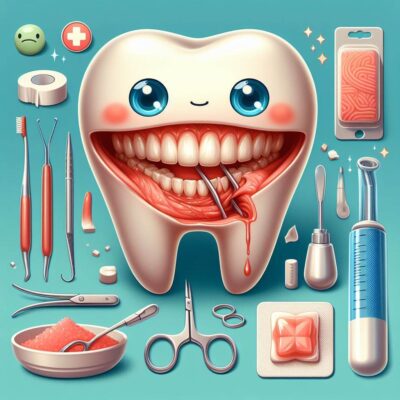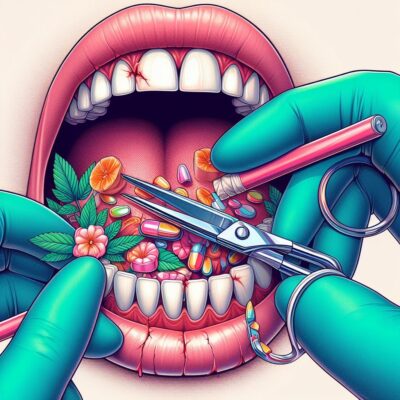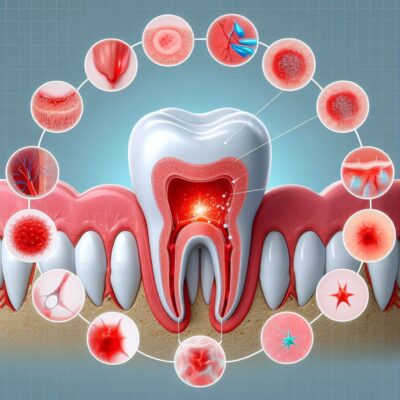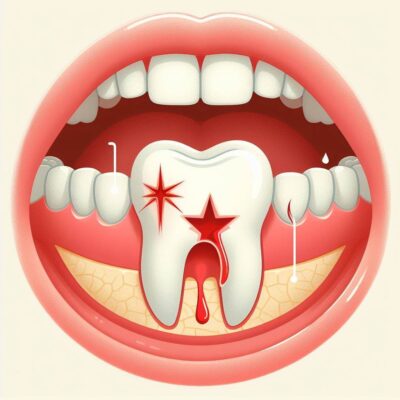
Dealing with a cut on your gums can be both uncomfortable and concerning. Whether it’s from accidentally biting down too hard or from aggressive brushing, these cuts can cause pain and irritation, making it difficult to eat or drink comfortably.
However, there’s good news – healing a cut on your gums is entirely possible with the right approach. In this article, “Cut On Gums 6 Easy Ways To Heal It” We’ll explore six easy and effective ways to heal a cut on your gums. From simple home remedies to over-the-counter solutions, we’ll cover everything you need to know to promote quick and effective healing.
By following these tips, you can soothe your gums, alleviate discomfort, and restore oral health in no time.
Cut On Gums 6 Easy Ways To Heal It

1. Rinse with Salt Water:
One of the easiest and most effective ways to promote gum healing is by rinsing your mouth with salt water. Simply mix a teaspoon of salt into a glass of warm water and swish it around your mouth for about 30 seconds. Salt water helps to reduce inflammation, kill bacteria, and promote healing.
2. Apply Aloe Vera Gel:
Aloe vera gel is known for its soothing and healing properties, making it an excellent remedy for cuts and wounds. Apply a small amount of pure aloe vera gel directly onto the cut on your gums and leave it on for a few minutes before rinsing your mouth with water. Repeat this process several times a day for optimal results.
3. Use Honey:
Honey is another natural remedy that can help promote gum healing. Apply a small amount of raw honey onto the cut on your gums and leave it on for a few minutes before rinsing your mouth. Honey has antibacterial properties and can help reduce inflammation while promoting tissue regeneration.
4. Avoid Irritants:
To prevent further irritation and promote healing, avoid consuming spicy or acidic foods, as well as alcohol and tobacco products. These substances can irritate the cut on your gums and delay the healing process.
5. Apply Vitamin E Oil:
Vitamin E oil is known for its skin-healing properties and can be beneficial for promoting gum healing as well. Gently massage a small amount of vitamin E oil onto the cut on your gums and leave it on overnight. Rinse your mouth with water in the morning.
6. Over-the-Counter Products:
In addition to home remedies, there are several over-the-counter products available that can help promote gum healing, such as oral gels and mouthwashes specifically designed for oral wounds. Follow the instructions on the packaging for best results.
By following these six easy ways to heal a cut on your gums, you can promote quick and effective healing and alleviate discomfort. If the cut does not heal within a week or if you experience severe pain or signs of infection, be sure to consult with your dentist for further evaluation and treatment. I hope this answers the question Cut On Gums 6 Easy Ways To Heal It.
What Causes The Cut In Gums
Experiencing a cut in your gums can be a discomforting and sometimes painful ordeal. From seemingly harmless activities like eating or brushing your teeth to more serious dental issues, there are several potential causes behind these cuts.
Understanding what leads to cuts in the gums is essential for preventing them in the future and maintaining optimal oral health. In this article, we’ll explore the common culprits behind gum cuts, ranging from everyday habits to underlying dental conditions.
By identifying these causes, you can take proactive steps to protect your gums and minimize the risk of experiencing painful cuts.
Causes The Cut In Gums:
1. Trauma from Brushing:
Aggressive brushing with a hard-bristled toothbrush or improper technique can lead to cuts in the gums. Brushing too vigorously or using excessive force can irritate the delicate gum tissue, causing it to tear or bleed.
2. Accidental Biting:
Accidentally biting down on hard objects, such as food or utensils, can cause cuts or injuries to the gums. This is particularly common when eating crunchy or hard foods or when chewing on objects like pens or pencils absentmindedly.
3. Dental Appliances:
Ill-fitting dental appliances, such as dentures or braces, can rub against the gums and cause irritation or cuts. Poorly designed or improperly adjusted dental appliances can create friction against the gum tissue, leading to discomfort and injury.
4. Sharp Food Particles:
Consuming sharp or abrasive foods, such as chips, crackers, or crusty bread, can sometimes cause cuts or abrasions in the gums. These food particles can poke or scratch the delicate gum tissue, especially if eaten hastily or without proper chewing.
5. Oral Health Conditions:
Underlying oral health conditions, such as gum disease (gingivitis or periodontitis), can make the gums more susceptible to cuts or injuries. Inflamed or infected gum tissue is more fragile and prone to bleeding, making it easier for cuts to occur even with minimal trauma.
6. Medications:
Certain medications, such as blood thinners or drugs that reduce saliva production, can increase the risk of gum cuts or bleeding. These medications can affect blood clotting and saliva production, making the gum tissue more susceptible to injury and slower to heal.
7. Chemical Irritants:
Exposure to harsh chemicals in oral care products, such as mouthwashes or toothpaste, can sometimes irritate the gums and lead to cuts or sores. Allergic reactions or sensitivity to certain ingredients in these products can further exacerbate the problem.
By understanding the various factors that can cause cuts in the gums, you can take proactive steps to protect your oral health and prevent injuries.
Practicing proper oral hygiene, using a soft-bristled toothbrush, being mindful of your eating habits, and addressing any underlying dental issues can help minimize the risk of experiencing painful cuts in the gums. If you notice persistent or severe gum cuts, be sure to consult with your dentist for further evaluation and treatment.
How Long Do Cut Gums Take To Heal

Dealing with a cut in the gums can be a bothersome experience, impacting everyday activities like eating, drinking, and even speaking. While these cuts are often minor and heal on their own, the duration of the healing process can vary depending on various factors.
Understanding how long it takes for cut gums to heal is essential for managing discomfort and knowing when to seek further medical attention if needed. In this article, we’ll explore the typical timeline for healing cut gums, factors that can influence the healing process, and tips for promoting faster recovery.
By gaining insights into the healing journey of cut gums, individuals can take proactive steps to support oral health and alleviate discomfort.
Time Take To Heal Cut Gums:
The healing time for cut gums can vary depending on several factors, including the severity of the cut, individual health factors, and adherence to proper oral hygiene practices. Here’s a general overview of the healing timeline for cut gums:
Initial Stage (1-3 days):
In the first few days following the injury, the body initiates the healing process by forming a blood clot at the site of the cut. This blood clot acts as a protective barrier and provides a foundation for tissue regeneration.
Granulation Stage (3-7 days):
Over the next several days, new tissue begins to form at the site of the cut, a process known as granulation. The wound may appear pink or red as blood vessels develop, and the tissue gradually starts to close.
Maturation Stage (7-14 days):
In the final stage of healing, the new tissue matures and remodels, gradually strengthening and closing the wound. By the end of the second week, the cut gums should be well on their way to full recovery, with minimal discomfort and swelling.
Factors such as overall health, immune function, and oral hygiene habits can influence the healing time for cut gums. Individuals with compromised immune systems, poor oral hygiene, or underlying medical conditions may experience delayed healing or complications.
Additionally, practicing proper oral hygiene, avoiding irritants, and following any recommendations from healthcare professionals can help promote faster healing and reduce the risk of complications.
If the cut gums do not show signs of improvement or if there are concerns about infection, it’s important to seek medical attention from a dentist or healthcare provider for further evaluation and treatment.
Treatment Of Cut Gums

Dealing with a cut on the gums can be uncomfortable and even painful. Whether caused by accidental biting, aggressive brushing, or other factors, these cuts can make everyday activities like eating and drinking challenging.
Fortunately, there are effective treatments available to promote healing and alleviate discomfort. In this article, we’ll explore various treatment options for cuts on the gums, ranging from simple home remedies to professional interventions.
By understanding these treatment options, individuals can take proactive steps to address cut gums and restore oral health.
Understanding Individual Treatment:
Treating a cut on the gums involves a combination of home care and, in some cases, professional intervention. Here are several treatment options to consider:
1. Rinse with Salt Water:
One of the simplest and most effective treatments for cut gums is rinsing with salt water. Mix a teaspoon of salt into a glass of warm water and rinse your mouth with the solution several times a day. Salt water helps to reduce inflammation, kill bacteria, and promote healing.
2. Apply Pressure:
If the cut is bleeding, apply gentle pressure with a clean piece of gauze or cloth to help stop the bleeding. Hold the pressure for a few minutes until the bleeding subsides.
3. Apply a Cold Compress:
Applying a cold compress to the outside of the mouth can help reduce swelling and alleviate pain associated with cut gums. Wrap a few ice cubes in a towel and apply it to the affected area for 10-15 minutes at a time.
4. Avoid Irritants:
To prevent further irritation and promote healing, avoid consuming spicy or acidic foods, as well as alcohol and tobacco products. These substances can irritate the cut gums and delay the healing process.
5. Over-the-Counter Pain Relief:
Over-the-counter pain relief medications, such as ibuprofen or acetaminophen, can help alleviate pain and discomfort associated with cut gums. Follow the dosage instructions on the packaging and consult with a healthcare professional if you have any concerns.
6. Professional Intervention:
In some cases, cuts on the gums may require professional intervention, especially if they are deep, persistent, or accompanied by signs of infection. Dentists may recommend procedures such as suturing or applying topical medications to promote healing and prevent complications.
By following these treatment options, individuals can effectively address cut gums and promote healing. If the cut does not improve within a few days or if there are signs of infection, it’s important to seek professional dental care for further evaluation and treatment.
Appearance Of Cut On Gums

The appearance of a cut on the gums can be alarming and uncomfortable, often causing pain and irritation. These cuts, also known as gum lacerations, can occur for various reasons, including accidental biting, aggressive brushing, or underlying dental issues.
Understanding the appearance of a cut on the gums is essential for identifying and addressing the issue promptly. In this article, we’ll explore what a cut on the gums looks like, common symptoms associated with gum lacerations, and when to seek professional dental care.
By recognizing the signs and symptoms of a cut on the gums, individuals can take appropriate steps to promote healing and alleviate discomfort.
Appearances:
A cut on the gums can manifest in several ways, depending on the severity and location of the injury. Here are some common characteristics and symptoms associated with gum lacerations:
1. Bleeding:
One of the most noticeable signs of a cut on the gums is bleeding. The cut may bleed profusely, especially if it is deep or located in an area with a rich blood supply. The blood may appear bright red and may continue to ooze for several minutes or even hours after the injury.
2. Pain:
Gum lacerations can cause varying degrees of pain and discomfort. The pain may be sharp or throbbing and may worsen when eating, drinking, or brushing the teeth. The severity of the pain often depends on the size and depth of the cut.
3. Swelling:
Inflammation and swelling are common symptoms of gum lacerations. The gums around the cut may appear red, swollen, and tender to the touch. Swelling may increase in the hours following the injury and gradually subside as the healing process progresses.
4. Visible Wound:
Depending on the location of the cut, it may be visible to the naked eye. The wound may appear as a small tear or abrasion on the surface of the gums, accompanied by surrounding redness and inflammation. In some cases, the cut may be hidden between the teeth or under the gum line.
5. Difficulty Eating:
Gum lacerations can make eating and drinking uncomfortable, especially if the cut is located in an area that comes into contact with food or beverages. Individuals may experience pain or sensitivity when chewing, swallowing, or drinking hot or cold liquids.
6. Bad Breath:
In some cases, gum lacerations may lead to bad breath or an unpleasant taste in the mouth. This is often due to the presence of blood and bacteria in the wound, which can contribute to oral odor.
By recognizing the appearance and symptoms of a cut on the gums, individuals can take appropriate steps to address the issue and promote healing. If the cut is severe, persistent, or accompanied by signs of infection, it’s important to seek professional dental care for further evaluation and treatment.
When You Need To Seek Care

Experiencing a cut on the gums can be uncomfortable and concerning, prompting many to wonder when it’s necessary to seek professional care. While minor cuts may heal on their own with proper home care, there are instances where seeking medical attention is crucial for optimal healing and prevention of complications.
Understanding when to seek care for a cut on the gums is essential for managing discomfort and ensuring proper treatment. In this article, we’ll explore the signs and symptoms that indicate the need for professional dental care, as well as the potential risks of neglecting a cut on the gums.
By recognizing these warning signs, individuals can take proactive steps to address the issue and promote optimal oral health.
Guide On Need To Seek Care:
Knowing when to seek care for a cut on the gums can help prevent complications and promote optimal healing. Here are several signs and symptoms that indicate the need for professional dental care:
1. Excessive Bleeding:
If the cut on your gums is bleeding profusely and does not stop within a few minutes of applying pressure, it’s essential to seek medical attention. Excessive bleeding may indicate a deep or serious injury that requires professional treatment.
2. Severe Pain:
Intense or persistent pain associated with a cut on the gums may indicate underlying issues such as infection or nerve damage. If over-the-counter pain relievers are not providing adequate relief, it’s important to consult with a dentist for further evaluation and treatment.
3. Signs of Infection:
Symptoms of infection, such as swelling, redness, warmth, or pus discharge around the cut, require prompt attention from a dental professional. Left untreated, an infected cut on the gums can lead to complications such as abscess formation or spread of infection.
4. Difficulty Eating or Drinking:
If the cut on your gums makes it difficult to eat, drink, or perform daily activities, it’s advisable to seek care from a dentist. Difficulty chewing or swallowing may indicate a more significant injury or underlying dental issue that requires attention.
5. Persistent Symptoms:
If the symptoms associated with the cut on your gums persist or worsen over time, despite home remedies and self-care measures, it’s essential to consult with a dental professional. Persistent pain, bleeding, or swelling may indicate an unresolved issue that requires professional evaluation and treatment.
6. Underlying Health Conditions:
Individuals with underlying health conditions such as diabetes compromised immune function, or bleeding disorders may be at higher risk of complications from gum lacerations. It’s important for these individuals to seek prompt care from a dentist to prevent potential complications.
By recognizing these signs and symptoms, individuals can take proactive steps to address a cut on the gums and prevent complications. If you experience any of these warning signs or have concerns about the healing process, it’s important to seek care from a dental professional for further evaluation and treatment.
Conclusion:
Dealing with a cut on the gums can be uncomfortable and worrisome, but with the right approach, healing is entirely feasible. By incorporating simple yet effective methods into your routine, you can support the healing process and alleviate discomfort.
Whether it’s rinsing with salt water, applying soothing aloe vera gel, or practicing good oral hygiene, these easy steps can make a significant difference in promoting gum health. Remember to consult with a healthcare professional if you experience persistent symptoms or concerns about the healing process.
With patience, proper care, and guidance from healthcare professionals, you can expedite the healing of a cut on your gums and restore comfort to your oral health. I hope now you’re fully aware of Cut On Gums 6 Easy Ways To Heal It.
FAQs:
Q1: How long does it take for a cut on the gums to heal?
A: The healing time for a cut on the gums varies depending on factors such as the severity of the cut, individual health, and adherence to treatment. Generally, it can take anywhere from a few days to a couple of weeks for a gum cut to heal completely.
Q2: Can I use over-the-counter pain relievers for a cut on the gums?
A: Yes, over-the-counter pain relievers such as ibuprofen or acetaminophen can help alleviate pain and discomfort associated with a cut on the gums. Follow the recommended dosage and consult with a healthcare professional if needed.
Q3: Should I avoid certain foods when healing a cut on the gums?
A: It’s advisable to avoid consuming spicy or acidic foods, as well as alcohol and tobacco products, as these can irritate the cut on the gums and hinder the healing process. Stick to soft, bland foods and maintain good oral hygiene. “Cut On Gums 6 Easy Ways To Heal It“
Q4: When should I seek professional care for a cut on the gums?
A: You should seek professional care if the cut is bleeding excessively, if you experience severe pain or signs of infection (such as swelling, redness, or pus), if symptoms persist or worsen, or if you have underlying health conditions that may affect healing. “Cut On Gums 6 Easy Ways To Heal It“
Q5: Can I speed up the healing process of a cut on the gums?
A: While healing time varies for each individual, there are steps you can take to promote faster healing, such as practicing good oral hygiene, avoiding irritants, using over-the-counter pain relievers as needed, and seeking professional intervention if necessary. “Cut On Gums 6 Easy Ways To Heal It“
